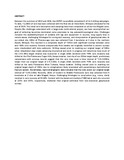The hominin sites and paleolakes drilling project hspdp drilling campaigns the trials and triumphs of trying the unique and new

View/
Date
2014-10Author
Campisano, Christopher J
Cohen, Andrew S
Asrat, Asfawossen
Feibel, Craig S
Kingston, John D
Lamb, Henry F.
Olago, Daniel O.
Owen, R. Bernhart
Renaut, Robin W.
Language
enMetadata
Show full item recordAbstract
Between the summers of 2013 and 2014, the HSPDP successfully completed 4 of its 5 drilling campaigns. To date, >1,200m of core has been collected with the final site at Chew Bahir, Ethiopia scheduled for the end of 2014. The initial core description and sampling have been completed on all but the Magadi cores. Despite the challenges associated with a large-scale multinational project, we have accomplished our goal of collecting lacustrine dominated cores proximate to key paleoanthropological sites. Challenges included the availability/import of suitable drill rigs and equipment in country, long supply lines in remote areas, challenging lithologies for coring and recovery, and interpretation of geophysical data. At our oldest site, 600m of Pliocene-age core was collected from 3 boreholes at 2 sites in the northern Awash, Ethiopia. This resulted in a composite depth of ~285m with significant overlap between cores and >96% core recovery. Several unexpectedly thick basalts not originally identified in seismic surveys were interbedded with lake sediments. Drilling ceased prior to reaching our original target of 500m when rehydrated clays made advancing impractical and work in progress will determine how much of the 2.9-3.8Ma target interval was recovered. A single 228m borehole with ~95% core recovery was drilled at the Plio-Pleistocene Tugen Hills, Kenya location. Just shy of our 250m target depth, preliminary comparisons with outcrop records suggest that this core may cover a time interval of ~2.5-3.45Ma, longer than our original target of 2.5-3.1Ma. A single 216m borehole with ~93% core recovery was drilled at the early Pleistocene West Turkana, Kenya location. Drilling ceased prior to reaching our original target depth of 350m due to complications likely associated with penetrating a hydrothermal fracture system. Nonetheless, tephrostratigraphic data indicates that the core covers our original target interval of ~1.45-2.0Ma. Recently, 202m of modern to Middle Pleistocene core was collected from 4 boreholes at 2 sites at Lake Magadi, Kenya. Challenging lithologies to core/collect (e.g., trona, chert) resulted in core recovery of 55-60%. Contact with the basement trachyte (~800 ka) at each site occurred at 137m and 197m, respectively, shallower than original estimates from low-resolution geophysical surveys.
Citation
Campisano, Christopher J., [et.al], (2014).The hominin sites and paleolakes drilling project hspdp drilling campaigns the trials and triumphs of trying the unique and new.GSA Annual Meeting in Vancouver, British Columbia (19–22 October 2014) General Information for this Meeting, PP. 292-1Publisher
University of Nairobi
